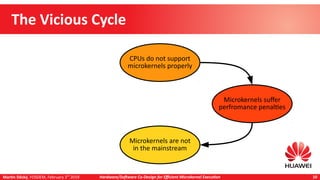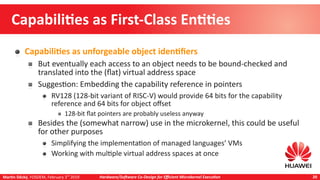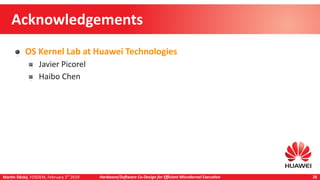Hardware/Software Co-Design for Efficient Microkernel Execution
- 1. Hardware/Software Co-Design for Efficient Microkernel Execution Martin Děcký [email protected] February 2019
- 2. Martin Děcký, FOSDEM, February 3rd 2019 Hardware/Software Co-Design for Efficient Microkernel Execution 2 Who Am I Passionate programmer and operating systems enthusiast With a specific inclination towards multiserver microkernels HelenOS developer since 2004 Research Scientist from 2006 to 2018 Charles University (Prague), Distributed Systems Research Group Senior Research Engineer since 2017 Huawei Technologies (Munich), German Research Center, Central Software Institute, OS Kernel Lab
- 3. 3Martin Děcký, FOSDEM, February 3rd 2019 Hardware/Software Co-Design for Efficient Microkernel Execution Microkernel Multiserver Systems are better than Monolithic Systems 3
- 4. Martin Děcký, FOSDEM, February 3rd 2019 Hardware/Software Co-Design for Efficient Microkernel Execution 4 Monolithic OS Design is Flawed Biggs S., Lee D., Heiser G.: The Jury Is In: Monolithic OS Design Is Flawed: Microkernel-based Designs Improve Security, ACM 9th Asia- Pacific Workshop on Systems (APSys), 2018 “While intuitive, the benefits of the small TCB have not been quantified to date. We address this by a study of critical Linux CVEs, where we examine whether they would be prevented or mitigated by a microkernel-based design. We find that almost all exploits are at least mitigated to less than critical severity, and 40 % completely eliminated by an OS design based on a verified microkernel, such as seL4.”
- 5. 5Martin Děcký, FOSDEM, February 3rd 2019 Hardware/Software Co-Design for Efficient Microkernel Execution Problem Statement5
- 6. Martin Děcký, FOSDEM, February 3rd 2019 Hardware/Software Co-Design for Efficient Microkernel Execution 6 Problem Statement Microkernel design ideas go as back as 1969 RC 4000 Multiprogramming System nucleus (Per Brinch Hansen) Isolation of unprivileged processes, inter-process communication, hierarchical control Even after 50 years they are not fully accepted as mainstream Hardware and software used to be designed independently Designing CPUs used to be an extremely complicated and costly process Operating systems used to be written after the CPUs were designed Hardware designs used to be rather conservative
- 7. Martin Děcký, FOSDEM, February 3rd 2019 Hardware/Software Co-Design for Efficient Microkernel Execution 7 Problem Statement (2) Mainstream ISAs used to be designed in a rather conservative way Can you name some really revolutionary ISA features since IBM System/370 Advanced Function? Requirements on the new ISAs usually follow the needs of the mainstream operating systems running on the past ISAs No wonder microkernels suffer performance penalties compared to monolithic systems The more fine-grained the architecture, the more penalties it suffers Let us design the hardware with microkernels in mind!
- 8. Martin Děcký, FOSDEM, February 3rd 2019 Hardware/Software Co-Design for Efficient Microkernel Execution 8 The Vicious Cycle CPUs do not support microkernels properly
- 9. Martin Děcký, FOSDEM, February 3rd 2019 Hardware/Software Co-Design for Efficient Microkernel Execution 9 The Vicious Cycle CPUs do not support microkernels properly Microkernels suffer perfromance penalties
- 10. Martin Děcký, FOSDEM, February 3rd 2019 Hardware/Software Co-Design for Efficient Microkernel Execution 10 The Vicious Cycle CPUs do not support microkernels properly Microkernels are not in the mainstream Microkernels suffer perfromance penalties
- 11. Martin Děcký, FOSDEM, February 3rd 2019 Hardware/Software Co-Design for Efficient Microkernel Execution 11 The Vicious Cycle CPUs do not support microkernels properly Microkernels are not in the mainstream Microkernels suffer perfromance penalties No requirements on CPUs from microkernels
- 12. Martin Děcký, FOSDEM, February 3rd 2019 Hardware/Software Co-Design for Efficient Microkernel Execution 12 The Vicious Cycle CPUs do not support microkernels properly Microkernels are not in the mainstream Microkernels suffer perfromance penalties No requirements on CPUs from microkernels
- 13. 13Martin Děcký, FOSDEM, February 3rd 2019 Hardware/Software Co-Design for Efficient Microkernel Execution Any Ideas?
- 14. Martin Děcký, FOSDEM, February 3rd 2019 Hardware/Software Co-Design for Efficient Microkernel Execution 14 Communication between Address Spaces Control and data flow between subsystems Monolithic kernel Function calls Passing arguments in registers and on the stack Passing direct pointers to memory structures Multiserver microkernel IPC via microkernel syscalls Passing arguments in a subset of registers Privilege level switch, address space switch Scheduling (in case of asynchronous IPC) Data copying or memory sharing with page granularity
- 15. Martin Děcký, FOSDEM, February 3rd 2019 Hardware/Software Co-Design for Efficient Microkernel Execution 15 Communication between Address Spaces (2) Is the kernel round-trip of the IPC necessary? Suggestion for synchronous IPC: Extended Jump/Call and Return instructions that also switch the address space Communicating parties identified by a “call gate” (capability) containing the target address space and the PC of the IPC handler (implicit for return) Call gates stored in a TLB-like hardware cache (CLB) CLB populated by the microkernel similarly to TLB-only memory management architecture Suggestion for asynchronous IPC: Using CPU cache lines as the buffers for the messages Async Jump/Call, Async Return and Async Receive instructions Using the CPU cache like an extended register stack engine
- 16. Martin Děcký, FOSDEM, February 3rd 2019 Hardware/Software Co-Design for Efficient Microkernel Execution 16 Communication between Address Spaces (3) Bulk data Observation: Memory sharing is actually quite efficient for large amounts of data (multiple pages) Overhead is caused primarily by creating and tearing down the shared pages Data needs to be page-aligned Sub-page granularity and dynamic data structures Suggestion: Using CPU cache lines as shared buffers Much finer granularity than pages (typically 64 to 128 bytes) A separate virtual-to-cache mapping mechanism before the standard virtual-to-physical mapping
- 17. Martin Děcký, FOSDEM, February 3rd 2019 Hardware/Software Co-Design for Efficient Microkernel Execution 17 Fast Context Switching Current microsecond-scale latency hiding mechanisms Hardware multi-threading Effective Does not scale beyond a few threads Operating system context switching Scales for any thread count Too slow (order of 10 µs) Goal: Finding a sweet spot between the two mechanisms
- 18. Martin Děcký, FOSDEM, February 3rd 2019 Hardware/Software Co-Design for Efficient Microkernel Execution 18 Fast Context Switching (2) Suggestion: Hardware cache for contexts Again, similar mechanism to TLB-only memory management Dedicated instructions for context store, context restore, context switch, context save, context load Context data could be potentially ABI-optimized Autonomous mechanism for event-triggered context switch (e.g. external interrupt) Efficient hardware mechanism for latency hiding The equivalent of fine/coarse-grained simultaneous multithreading The software scheduler is in charge of setting the scheduler policy The CPU is in charge of scheduling the contexts based on ALU, cache and other resource availability
- 19. Martin Děcký, FOSDEM, February 3rd 2019 Hardware/Software Co-Design for Efficient Microkernel Execution 19 User Space Interrupt Processing Extension of the fast context switching mechanism Efficient delivery of interrupt events to user space device drivers Without the routine microkernel intervention An interrupt could be directly handled by a preconfigured hardware context in user space A clear path towards moving even the timer interrupt handler and the scheduler from kernel space to user space Going back to interrupt-driven handling of peripherals with extreme low latency requirements (instead of polling) The usual pain point: Level-triggered interrupts Some coordination with the platform interrupt controller is probably needed to automatically mask the interrupt source
- 20. Martin Děcký, FOSDEM, February 3rd 2019 Hardware/Software Co-Design for Efficient Microkernel Execution 20 Capabilities as First-Class Entities Capabilities as unforgeable object identifiers But eventually each access to an object needs to be bound-checked and translated into the (flat) virtual address space Suggestion: Embedding the capability reference in pointers RV128 (128-bit variant of RISC-V) would provide 64 bits for the capability reference and 64 bits for object offset 128-bit flat pointers are probably useless anyway Besides the (somewhat narrow) use in the microkernel, this could be useful for other purposes Simplifying the implementation of managed languages’ VMs Working with multiple virtual address spaces at once
- 21. Martin Děcký, FOSDEM, February 3rd 2019 Hardware/Software Co-Design for Efficient Microkernel Execution 21 Prior Art Nordström S., Lindh L., Johansson L., Skoglund T.: Application Specific Real-Time Microkernel in Hardware, 14th IEEE-NPSS Real Time Conference, 2005 Offloading basic microkernel operations (e.g. thread creation, context switching) to hardware shown to improve performance by 15 % on average and up to 73 % This was a coarse-grained approach Hardware message passing in Intel SCC and Tilera TILE-G64/TILE- Pro64 Asynchronous message passing with tight software integration
- 22. Martin Děcký, FOSDEM, February 3rd 2019 Hardware/Software Co-Design for Efficient Microkernel Execution 22 Prior Art (2) Hajj I. E,, Merritt A., Zellweger G., Milojicic D., Achermann R., Faraboschi P., Hwu W., Roscoe T., Schwan K.: SpaceJMP: Programming with Multiple Virtual Address Spaces, 21st ACM ASPLOS, 2016 Practical programming model for using multiple virtual address spaces on commodity hardware (evaluated on DragonFly BSD and Barrelfish) Useful for data-centric applications for sharing large amounts of memory between processes Intel IA-32 Task State Segment (TSS) Hardware-based context switching Historically, it has been used by Linux The primary reason for removal was not performance, but portability
- 23. Martin Děcký, FOSDEM, February 3rd 2019 Hardware/Software Co-Design for Efficient Microkernel Execution 23 Prior Art (3) Intel VT-x VM Functions (VMFUNC) Efficient cross-VM function calls Switching the EPT and passing register arguments Current implementation limited to 512 entry points Practically usable even for very fine-grained virtualization with the granularity of individual functions Liu Y., Zhou T., Chen K., Chen H., Xia Y.: Thwarting Memory Disclosure with Efficient Hypervisor-enforced Intra-domain Isolation, 22nd ACM SIGSAC Conference on Computer and Communications Security, 2015 – “The cost of a VMFUNC is similar with a syscall” – “… hypervisor-level protection at the cost of system calls” SkyBridge paper to appear at EuroSys 2019
- 24. Martin Děcký, FOSDEM, February 3rd 2019 Hardware/Software Co-Design for Efficient Microkernel Execution 24 Prior Art (4) Woodruff J., Watson R. N. M., Chisnall D., Moore S., Anderson J., Davis B., Laurie B., Neumann P. G., Norton R., Roe. M.: The CHERI capability model: Revisiting RISC in the an age of risk, 41st ACM Annual International Symposium on Computer Architecture, 2014 Hardware-based capability model for byte-granularity memory protection Extension of the 64-bit MIPS ISA Evaluated on an extended MIPS R4000 FPGA soft-core 32 capability registers (256 bits) Limitation: Inflexible design mostly due to the tight backward compatibility with a 64-bit ISA Intel MPX Several design and implementation issues, deemed not production-ready
- 25. Martin Děcký, FOSDEM, February 3rd 2019 Hardware/Software Co-Design for Efficient Microkernel Execution 25 Summary Traditionally, hardware has not been designed to accommodate the requirements of microkernel multiserver operating systems Microkernels thus suffer performance penalties This prevented them from replacing monolithic operating systems and closed the vicious cycle Hardware design is hopefully becoming more accessible and democratic E.g. RISC-V Co-designing the hardware and software might help us gain the benefits of the microkernel multiserver design with no performance penalties However, it requires some out-of-the-box thinking
- 26. Martin Děcký, FOSDEM, February 3rd 2019 Hardware/Software Co-Design for Efficient Microkernel Execution 26 Acknowledgements OS Kernel Lab at Huawei Technologies Javier Picorel Haibo Chen
- 27. Martin Děcký, FOSDEM, February 3rd 2019 Hardware/Software Co-Design for Efficient Microkernel Execution 27 Huawei Dresden R&D Lab Focusing on microkernel research, design and development Basic research Applied research Prototype development Collaboration with academia and other technology companies Looking for senior operating system researchers, designers, developers and experts Previous microkernel experience is a big plus “A startup within a large company” Shaping the future product portfolio of Huawei Including hardware/software co-design via HiSilicon
- 28. 28Martin Děcký, FOSDEM, February 3rd 2019 Hardware/Software Co-Design for Efficient Microkernel Execution Q&A
- 29. Thank You!





























